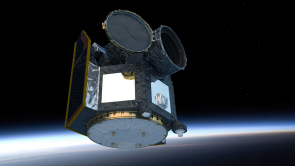Operations
CHEOPS was successfully launched on 18 December 2019, at 08:54:20 UTC, as an auxiliary passenger on a Soyuz rocket from the Kourou Spaceport in French Guiana.
 |
| Artist's impression of CHEOPS. Credit: ESA/ATG medialab |
CHEOPS will operate in a Sun-synchronous orbit, with an altitude of 700 km and a local time of the ascending node of 06:00. This choice permits the rear of the spacecraft to be permanently Sun-pointed, is optimal for uninterrupted observations, and keeps thermal variations of the spacecraft and Earth stray light on the satellite to a minimum as the orbital plane follows, as closely as possible, the day/night terminator.
Planning of the observations will be carried out at the Science Operations Centre (SOC) and communicated to the Mission Operations Centre (MOC), where spacecraft commanding sequences will be uplinked via ground station antennas at Torrejón (nominal) and Villafranca (backup) near Madrid. The spacecraft telemetry will be routed from the MOC to the SOC for calibration, processing and archiving.
The data budget for CHEOPS is 1.2 Gb/day, with an S-band system providing data downlink, telemetry and telecommanding. The nominal duration of science operations is 3.5 years, to enable the execution of the proposed core programme, with an allocation of 20% of the observing time available to the scientific community.
Execution of the launch and early orbit phase (LEOP) and In-Orbit Commissioning (IOC) will be performed by the spacecraft contractor. Following the successful In-Orbit Commissioning of the spacecraft, responsibility for CHEOPS operations will be taken over by the CHEOPS Mission Consortium. The MOC is under the responsibility of INTA in Torrejón de Ardoz, Spain, while the SOC and the overall coordination of the ground segment will be located at the University of Geneva (Switzerland).

